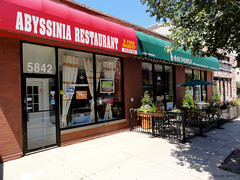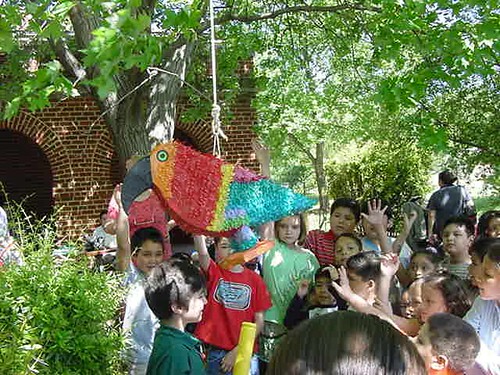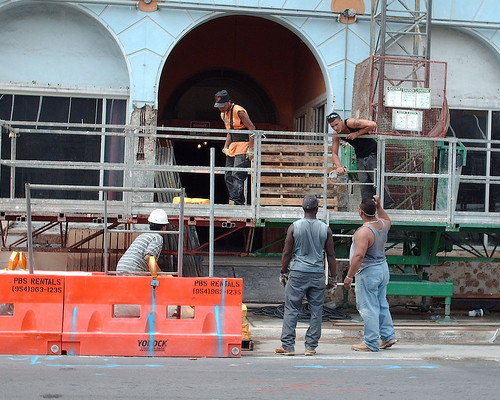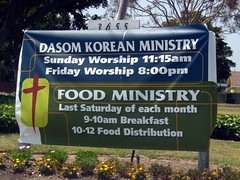Coming to America: immigration and sustainable communities

Posted May 9, 2011 at 1:39PM
I have been thinking, of late, about immigrants. This may be because it has now been a full year since the enactment of Arizona’s harsh and notorious legislation that targets illegal immigrants. It may also be because I have just finished writing a book about my own family’s rich history. All this got me to thinking about diversity as an ecological and socio-economic construct, and one that surely applies to sustainable communities. How does all this fit together?
(Today’s entry is a guest post from my friend and frequent collaborator Lee Epstein. All the words are Lee's; I researched and added the photos.)
Ecological diversity and community diversity
In these things, there is myth and there is reality, theory and proven facts. We know from a great deal of ecological  research over the years that ecological diversity -- species’ richness and variance -- lends significant strength to an environment. It enables longer chains of nutrient and energy cycles; it improves the gene pool to help the genetic expression of survival attributes; it creates a better ecological community overall by improving resilience in the face of stressors and disease. Now, exactly how the various niches in an environment evolved to a given point, that’s more where the theory comes in (just as when writing history, one must take known facts and circumstances and weave them into a plausible narrative). But a healthy environment is usually pretty recognizable, while an unhealthy one is equally identifiable.
research over the years that ecological diversity -- species’ richness and variance -- lends significant strength to an environment. It enables longer chains of nutrient and energy cycles; it improves the gene pool to help the genetic expression of survival attributes; it creates a better ecological community overall by improving resilience in the face of stressors and disease. Now, exactly how the various niches in an environment evolved to a given point, that’s more where the theory comes in (just as when writing history, one must take known facts and circumstances and weave them into a plausible narrative). But a healthy environment is usually pretty recognizable, while an unhealthy one is equally identifiable.
I know that comparing organic environments and their evolution to that of social and political structures is rife with problems,  but humor me for a moment. A “healthy” urban place (city or county, town or village) is also pretty recognizable. There is a broad and deep exchange of economic energy, from very small business to large. There is diversity in the economy -- no one industry or employer is so dominant that, should it meet an untimely demise, so goes that community – so resilience to economic shocks is present. There is diversity in the population, lending interest and richness in the stories, backgrounds, languages, cultures (and cuisines!) expressed in the community. (We are, after all, almost all immigrants in America, whether we arrived on the Mayflower or flew in yesterday from Kandahar; only certain Native Americans can claim a several thousand year American heritage.)
but humor me for a moment. A “healthy” urban place (city or county, town or village) is also pretty recognizable. There is a broad and deep exchange of economic energy, from very small business to large. There is diversity in the economy -- no one industry or employer is so dominant that, should it meet an untimely demise, so goes that community – so resilience to economic shocks is present. There is diversity in the population, lending interest and richness in the stories, backgrounds, languages, cultures (and cuisines!) expressed in the community. (We are, after all, almost all immigrants in America, whether we arrived on the Mayflower or flew in yesterday from Kandahar; only certain Native Americans can claim a several thousand year American heritage.)  Finally, there is usually diversity in the community’s age structure as well, that includes old, young, and in-betweens.
Finally, there is usually diversity in the community’s age structure as well, that includes old, young, and in-betweens.
Many communities take a long time to get there, and various routes -- some of which were uncomfortable or even extraordinarily painful; immigration stories are not always pretty and pleasant. But the enormous energy, creativity, overall economic stability, and tremendous work ethic of the most diverse social and economic places are part and parcel of their relative success. Immigrants often supply the most basic, raw labor needed at the entry point on the economic ladder. Over time (sometimes a generation or two) and given equitable circumstances, immigrants scale that ladder to higher rungs, leaving openings at the bottom for the next generation of immigrants.
Why some of us worry
But diversity is not universally loved in America. Since our nation’s founding, there have always been those who welcomed new arrivals with open arms and the clear-eyed realization that here must come more hard workers -- and builders, and tax-payers, and consumers. There have also always been some who arrived earlier expressing a desire to keep the later come-here’s out – for an irrational fear of “strangers” and an equal distrust that they would actually provide an additive economic contribution rather than somehow the opposite.  Finally, there are some in the environmental community who see this more than “natural” increase in population in apocalyptic ecological terms: that such numbers inherently must challenge the land’s carrying capacity.
Finally, there are some in the environmental community who see this more than “natural” increase in population in apocalyptic ecological terms: that such numbers inherently must challenge the land’s carrying capacity.
While the latter is true (at some point, our numbers will exceed the capacity of the environment to absorb us, and begin doing irreversible harm to the environment), I don’t think we’re there yet. The United States still has many millions of acres of arable land, and millions more of forest. With wise stewardship of our wilderness and parks, and better, more diverse, and less damaging management of our agricultural lands and working forests for food and fiber, we should be able to provide for ourselves and others for many hundreds of years. At the same time, there are ways to manage our developed and developing areas so as to actually improve water quality. Indeed, “carrying capacity” is itself an inherently slippery concept, because ultimately a reading of whether we have reached  it depends upon our own tolerance and faculty for a given level of resource depletion or degradation; very little of our environment is “pure.”
it depends upon our own tolerance and faculty for a given level of resource depletion or degradation; very little of our environment is “pure.”
At the same time, we obviously need to consume less of almost everything, vastly increase energy efficiency, and develop and use energy from renewable sources. And of course, really, it’s not possible to make a blanket statement that we haven’t yet reached or exceeded the land’s carrying capacity, because such is so site specific -- there may well be particularly degraded places, or even unique but compromised ecological niches, where we have. This would likely be evident by a slow but gathering, seemingly irreversible, and a-historical downward trend in ecological health indices, including species diversity or disease, basic water quality or air quality parameters, and the like. We can, and should, be very guarded about how we treat such places, and certainly we should not only avoid taxing them to such a point (or any farther at all), but we should begin restoration efforts, in the hope they can recover.
In America, immigration is us; and brings value
Are our immigrants causing us to exceed our carrying capacity today? Again, the general response is “probably no.” On the other hand, they may be filling economic functions that are actually strengthening our cities in all the ways described above. (This essay isn’t about “illegal immigration,” per se. As a sovereign nation with admittedly difficult economic management issues, providing for those who arrive here outside the legal process can be difficult for state and local governments; we cannot have simply open borders. How we manage those who are now here illegally is another matter entirely. )
The bottom line is that immigration is as American as apple pie. Almost all of our families arrived here from somewhere else, sometime over the last couple hundred years. Should it really matter precisely when or under what circumstances?
The other bottom line is that immigration is generally good for, and part of, sustainable communities. It lends such places diversity, economic energy, and a capacity for development (versus pure physical growth), as long as the growth framework itself is carefully, thoughtfully, and sustainably planned, and then adequately and firmly managed.
Move your cursor over the images for credit information.
Lee Epstein is an attorney and land use planner working in the mid-Atlantic region.




